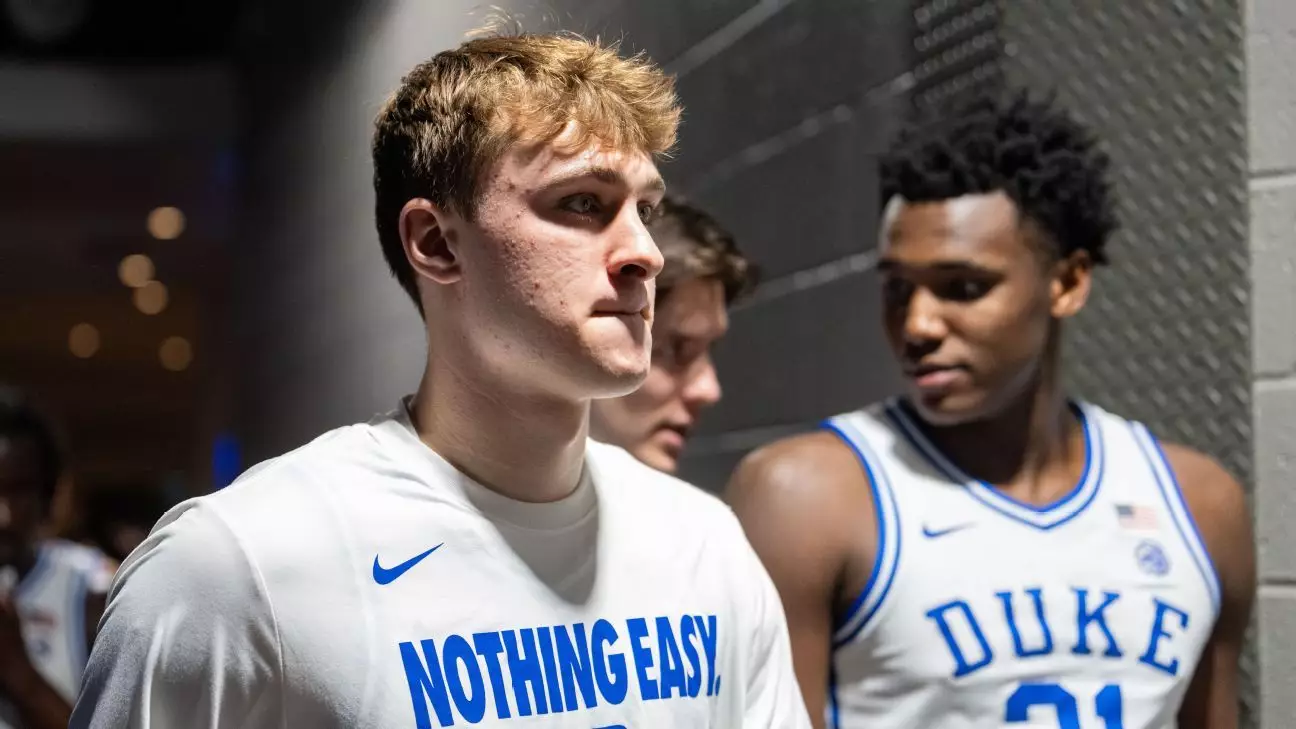Injuries are the cruelest of adversaries in sports, often striking at the most inopportune times. The recent ankle misfortune of Duke star Cooper Flagg during the ACC tournament is a case in point. Not only is Flagg an essential player for Duke, but he also represents the hopes of many as a projected top pick in the 2025 NBA draft. With the NCAA tournament looming, his injury sends ripples of concern through the Duke basketball community—a prompt for both reflection and a critical evaluation of the team’s resilience and adaptability.
Flagg’s accident is not merely an isolated incident; it reflects a broader narrative within college basketball. Teams invest so much in their star players, and the precarious nature of sports can turn a promising run into a desperate scramble for survival at any moment. As the NCAA governing body confirmed Flagg’s availability for March Madness, it simultaneously buttressed the notion that injuries can no longer be dismissed as mere bumps in the road. Duke’s ability to navigate this obstacle could determine whether they are serious contenders or merely another team aiming for an early exit.
Strategizing Without a Key Player
Recent injuries are forcing teams like Duke to rethink their strategies and game plans. Coach Jon Scheyer faced a dual challenge: devising tactics without Flagg while simultaneously preparing him for the rigors of the NCAA tournament. Malique Brown’s shoulder injury only adds to the unpredictability. These challenges reveal a fundamental issue within college athletics; despite the pressure to succeed, navigating injuries often leads to more significant implications than just immediate gameplay.
Duke has built a stellar reputation on its player development and adaptability. However, injuries place a glaring spotlight on their depth. Can substitutes rise to the occasion, or will they falter under the duress of high-stakes matchups? These questions are not mere hypotheticals but represent the crux of what elite programs must wrestle with in turbulent times.
The Broader Picture: The Weight of Expectations
Expectations hover over teams like a thick fog, and in the elite realm of NCAA basketball, they can suffocate. This season, Duke has been heralded as a potential champion, thanks in part to Flagg’s dazzling performances and his status as a frontrunner for prestigious awards. Yet, what happens when the one who shoulders those expectations falters? If anything, Flagg’s impending return is a moment for self-assessment for both him and the team.
The pressure cooker of college sports inflates dramatically during tournament season, and the balance between urgency and patience can be precarious. Flagg’s injury compels us to ponder, what sacrifices are teams making, and what risks are they willing to take? The culmination of iron-will messaging from coaches and media buzz can only go so far in mitigating an injury’s impact.
Community and Spirit: Team Dynamics Shift
With Flagg sidelined, the dynamic within the team shifts, forcing players to cultivate camaraderie that goes beyond just scoring points. Flagg’s role as a cheerleader on the sidelines during Duke’s nail-biting victory over North Carolina exemplifies a vital lesson in team spirit and unity, critical underpinnings of successful programs. While stats and strategies matter, it is often the relationships and collective morale that propel teams through tumultuous journeys.
Perhaps the best outcome of Flagg’s misfortune is that it may ignite a fire within the rest of the team—an opportunity for lesser-known players to step up into the limelight. This turn of events can foster character-building experiences that further strengthen team bonds, preparing them for whatever lies ahead in the NCAA tournament.
The Flawed System of Selection and Injuries
The injury to a pivotal player raises crucial questions about the integrity of the tournament selection process. Dan Gavitt’s reassurances regarding Flagg’s status may placate immediate concerns, but the inherent volatility in player health brings an unsettling reality to the forefront. Should a team’s seeding be contingent upon one player’s health status? More broadly, how fair is it to determine a team’s tournament fate when injuries—often beyond any player or coach’s control—could heavily skew results?
Injuries such as Flagg’s pose ethical dilemmas that highlight structural flaws in the NCAA framework. Seeding should encompass an entire team’s capabilities rather than hinge upon the fitness of one star player. As we reflect on Flagg, we must also initiate a dialogue around reforming the selection process to account for the uncertainties that define the human experience within sports. The implications are far-reaching, prompting a reevaluation of how resilience should be weighed against unpredictability.
As March approaches, the intersection of talent, injury, and resilience will be in sharp focus. Cooper Flagg’s road to recovery is not just a personal journey; it symbolizes the fragility of dreams and the unyielding spirit that defines college athletics.


Leave a Reply